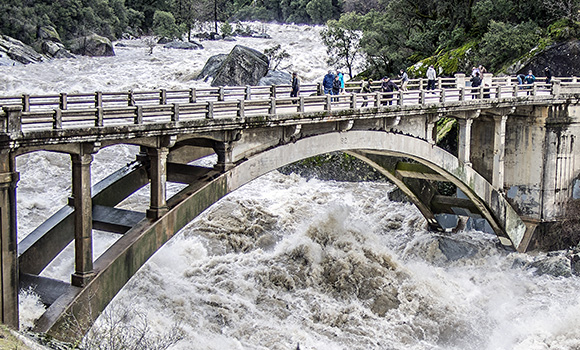Storms put dent in drought but not the need to restore California’s water balance

The Yuba River on January 8, swollen from storms over the weekend (Photo Credit: Larry Miller/Flickr)
California’s stormy deluge of rain is altering the drought outlook, at least for the now-full reservoirs in the northern part of the state. But the need to provide a sustainable and reliable water supply will never be low in priority in the years ahead.
Even before the drought, Californians used almost 10 million acre-feet a year more from reservoirs and aquifers than was replenished by nature. Something has to give–and the state needs to make moves this year to more sustainably manage its water.
That’s the call-to-action from Jay Ziegler, director of external affairs for The Nature Conservancy in California, who was featured in the Sacramento Bee this week with his op-ed “California’s water policy at potential tipping point.”
“But whether the drought is broken or not, Californians must act this year to achieve more sustainable long-term water management. California operates at a water deficit. Even in wet years, we use more surface and groundwater than is replenished by rainfall. It is not sustainable.
The recently enacted federal California drought bill and the arrival of a Trump administration will place additional pressure on California’s ability to manage water for the benefit of all the things we care about including wildlife, agriculture and cities.”
Ziegler cited recent progress such as the voter-approved $7 billion water bond and reforms that finally put groundwater under the state’s management responsibilities.
Moving forward, Ziegler listed additional steps to address California’s management challenges, including improved water monitoring and developing water financing reforms to improve quality and to capture and recycle more stormwater.
Solutions like these will require more investment, smart planning, and increased use of technology. The California Economic Summit helped in the development of a next generation of local infrastructure financing tools and created a detailed action plan for integrating resource planning and ecosystem services tools, while promoting data technology to aid in planning.
One of the top priorities of the Summit throughout last year and at the 2016 Summit was promoting the conservation, reuse, and capture of one million more acre-feet of water each year for the next decade.
To achieve this goal, the Summit sought innovative approaches to integrating water management across watersheds—helping each region more efficiently capture and reuse each drop as it moves from mountains to the sea.
Even if 2017 spells the end of years of drought for California, the work to put the state’s water systems in balance will continue.

Dr. Ansari on health care’s future amid demographic shifts
Original story on permanente.org During a recent CEO workgroup panel, “Advancing Your Culture…
December 23, 2024
Drs. Hoberman and Nguyen on preparing for health care AI
Original story on permanente.org Many questions surround the advancements of artificial intelligence in…
October 30, 2024